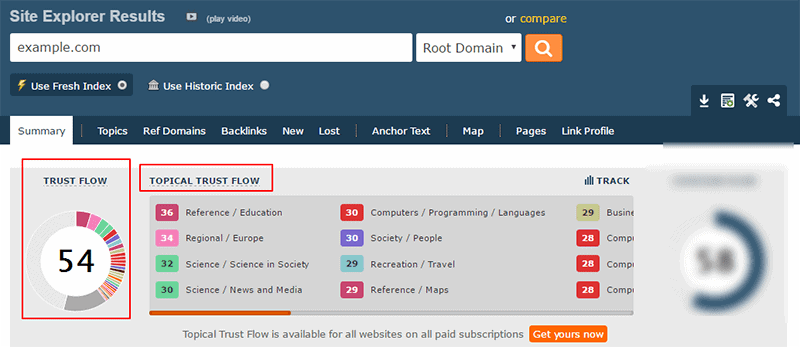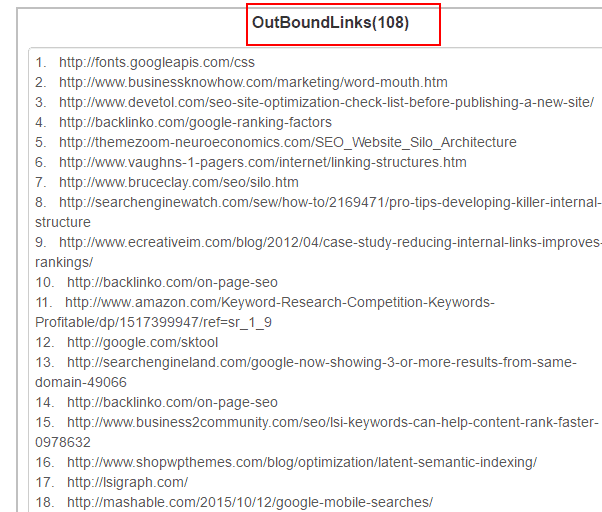13 IMPORTANT BACKLINK ANALYSIS METRICS FOR FASTER SEO
13 Important Backlink Analysis Metrics For Faster SEO
Backlink analysis is considered one of the most important factors in SEO. However, with a wide range of backlink analysis tools that are available today, doing a backlink analysis has become a daunting task.
With factors such as Page Authority, deep links, referring TLDs, backlink type data, etc, knowing which metrics are worth looking at from SEO perspective is difficult.
For this reason, we have drawn up a list of 13 key backlink metrics that are important & that you need to measure while doing a backlink analysis. Following this process will keep you from analyzing each & every metric, thereby saving precious time, and provide you actionable data that can help you to improve your SEO strategies.

#1. DOMAIN AUTHORITY (DA)
A key metric that helps you to understand the quality of a website, Domain Authority is measured based on three factors, namely domain age, size, and popularity.
The greater a website’s Domain Authority is, the higher it ranks on search engine and thus, it is an important metric to measure for your own website as well as that of your competitors’ site
How do you check the Domain Authority of a website?
Domain Authority is a metric developed by Moz and is usually calculated as a score out of 100 on a logarithmic scale. To check the domain authority of any website, you can use the Open Site Explorer tool
#2. PAGE AUTHORITY (PA)
Page Authority, too, is a metric developed by Moz that tells you the ranking of a single web page on Google. It focuses on an individual web page and the score is calculated out of 100. The higher the PA score of a web page the better its chances become of ranking well in search results
#3. RATIO OF BACKLINK TO REFERRING DOMAINS
In backlink analysis, it is important that you check the ratio of referring domains to backlinks. Why? Because Referring Domains are an indication of where your backlinks are coming from.
For example, if a page has 500 backlinks from 10 referring domains, the page is considered to be of low-quality or spammy by Google, and if you happen to link to this page, it could adversely affect your site’s page rank.
Thus, to avoid such circumstances, it is essential that you check website/URLs for their referring domains before you use their links on your website.

#4. TOTAL UNIQUE LINKING ROOT DOMAINS

Unique linking domain refers to the number of other websites that link to your site or web page. Analyzing this metric is important as it indicates whether a website is an authoritative site or not.
#5. TOTAL NUMBER OF C-CLASS IPS
This metric tells you if a website is sharing an IP address with another site. Since a link from a website that is sharing an IP address with other websites can have a negative impact on your site’s PageRank, it is important that you check the total number of C-class IPs before adding it to your backlink profile.
#6. ANCHOR TEXT DISTRIBUTION
Since the percentage of Exact Match Anchor text should be less than 50%, keeping an eye on the terms that are over-used is important. This metric helps you to identify manipulative link patterns and helps you in diversifying your anchor text to avoid over-optimization of targeted keywords. It is hard to say what is an ideal anchor text distribution, but as per my experience and what I saw is working and makes a link profile natural follows: Branded Anchor text: 40% Unique/Other anchor text: 25% Naked link anchor: 15%
#7. CITATION FLOW
A ranking metric developed by Majestic SEO, Citation Flow metric is similar to Google’s PageRank and tells you how influential a link (URL/page) is based on how many sites link to it.
The score is calculated out of 100 and the higher the citation flow of the website linking to your site, the more link juice you are able to acquire from it, even with fewer inbound links (backlinks).

#8. TRUST FLOW

As the name suggests, Trust Flow metric tells you how trustworthy a page/link is based on the quality of backlinks pointing to that website. This too is calculated out of 100 and a site with high trust flow indicates high-quality backlink profile.
#9. NUMBER OF INBOUND LINKS
As mentioned before, search engines give a higher value for backlinks from different domains and thus, by analyzing your web pages or domain, you are able to get information on how many inbound links, come from an external site to your website.
Inbound Links influence your Page Rank since search engines take multiple, relevant inbound links to a web page as a sign that the content on that page is useful. Measuring this metric will provide you with data that will help you to understand how effective your link building strategy is.
You can use tools like OpenLinkprofiler to check inbound link count, as it gives you an overview of all the incoming links (URL) on your web page along with other important information such as Anchor text, NoFollow links, and more
#10. NUMBER OF OUTBOUND LINKS
Another metric that influences Page Rank is the outbound links that send visitors from your site to some other website.

Outbound links play an important role in SEO as they help search engines to understand your niche, thereby increasing the trust and quality of your website. They also help you to build a relationship with other bloggers. Measuring this metric will help you enhance your SEO strategy.
#11. TOTAL LINKS VS FRESH LINKS
While total links help you understand how competitive a website is, measuring fresh links helps you determine how effective your link building strategy is. Just lookout for any sudden spike in the fresh incoming link, as it is an indication that unnatural link building activities are underway.
When you analyze a web page or domain, it is important that you take both this metric into account as it helps you to determine the link quality of a backlink
#12. SOCIAL MEDIA SHARE DISTRIBUTION
Another important metric that you need to measure, analyzing your social media share distribution statistics can help you determine the effectiveness of your content, and how it affects your conversion rate
You can use tools like Buzzsumo, Moz, Google Analytics to measure and track important social media metrics and leverage this information to improve your marketing strategy.
Examples...
Social Media Stats Worldwide | StatCounter Global Stats
This graph shows the stats of social media worldwide from July 2018 - July 2019. Facebook has 72.16%, Pinterest has 14.46% and Twitter has 6.06%.
Social Media: Percentage Market Share
Instagram: 1.43%
Facebook: 73.91%
Twitter: 6.18%
#13. SPAM SCORE
A new metric by Moz, Spam score takes into account 17 unique signals that can get you penalized by Google such as a large number of external links, abnormally small site markup, thin content, a high ratio of anchor text, etc.
The score is calculated from 0 to 17, with 0 indicating a spam probability of 0.5% and 17 indicating a spam probability of 100%. Measuring this metric can help you identify and fix issues on your site quickly, thereby preventing your site from getting banned or penalized.
#CONCLUSION
Backlink analysis can be an overwhelming task but by focusing only on key metrics you could make this task easier for yourself. Analyzing the above mentioned 13 backlink metrics will help you to judge good links from bad, thereby helping you improve your SEO and link building strategy. So follow this easy process, and track & measure these key metrics for a smarter SEO.
Also, here is a simple guide on how social bookmarking can boost your SEO campaign. Do check it out!
Like always, if you need a web hosting to launch a new website, then do check out this HostGator India review to know why HostGator is one the best web hosting providers in India. Also, make use of the HostGator coupons to save big on your purchase.


























Post a Comment